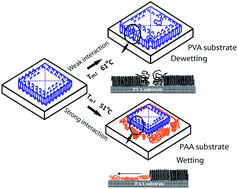Probing interfacial properties using a poly(ethylene oxide) single crystal
Abstract
Poly(ethylene oxide) (PEO) single crystals were grown from dilute solution using a self-seeding method. The PEO single crystals with uniform dimensions, homogeneous chemical and physical properties were used as a simplified ultrathin film system to probe the interfacial properties of different substrates. In situ studying the annealing and melting behavior of PEO single crystals on the PAA, amorphous PEO and PVA substrates were carried out using an atomic force microscope (AFM) equipped with a hot stage. The interaction force between the PEO modified probe and various substrates was measured at different temperatures, and the universal dependence of the interaction force between the probe and polymer substrate on the temperature was demonstrated. The wetting and dewetting behavior of PEO melt on the PAA and amorphous PEO and PVA substrates were observed and the spreading coefficient (S) was proposed to prejudge the spreading behavior of a polymer ultra-thin film on a solid substrate according to the interaction force. Different melting points were found and the initial melting of the PEO single crystals occurred at 51, 54 and 61 °C on the PAA, PEO and PVA substrates, respectively. How the interfacial energy affects the melting point of single crystals was demonstrated, and the theoretical prediction agrees well with the experimental results.


 Please wait while we load your content...
Please wait while we load your content...